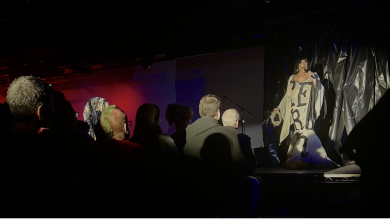Lily R. Mason’s Workshop for Writing Queer-Centered Sex Scenes

Photo by Marc Falardeau via CreativeCommons
Growing up as a queer woman, I often felt alienated by the cis-heteronormative notions of sex that many parts of society would bombard my generation with. I had to unlearn several problematic myths: that sex requires penis-in-vagina penetration, that masculine partners decide how things happen, that losing one’s virginity as a woman is supposed to hurt (when it shouldn’t) — among many other cringe-worthy notions. Regardless of their identities, it seems to me that almost everyone has to grapple with the ways sex may affect their relationships, due to the way sex is often politicized and scripted according to social norms — some, like LGBTQIA+ individuals, grappling more than others. It can be specifically alienating for one to feel like many parts of society look at their queer desire as unnatural, shameful, and illegitimate. Having healthy sex education and inclusive romantic media representation for all identities is crucial in order to dismantle oppressive institutions that have unfairly politicized the ways human beings embody themselves and relate to each other in today’s world.
That’s why, this Valentine’s Day, the UCLA Campus Resources Center hosted a small, intimate workshop led by Lily R. Mason called “Writing Queer-Centered Sex Scenes” from 3 p.m. – 5 p.m. in the UCLA LGBT Center. Mason is an accomplished author who has written many books about queer women in various genres — especially romance. She is passionate about creating and seeing more content that celebrates and affirms the existence of all kinds of love. However, having already hosted this workshop before, Mason unexpectedly yet effectively began her workshop by completely avoiding the topic of sex.
“Why do people write?” Mason asked instead. She surveyed everyone, taking the time to highlight specific answers, such as to normalize queer relationships, for narrative therapy, and to imagine a better world — all to crystallize her opening point that while everyone has different reasons, it can all be boiled down to the idea that “we [the queer community] write because we have to.” The first half of Mason’s workshop was largely focused on self-love, and was dedicated to writing any kind of queer-centered story in general. This was to highlight the point that the writing queer individuals need to see has to represent them in multiple and complex ways, beyond the detail that they do not (at least solely) experience cis-heteronormative attraction. To sum up her point: sex scenes in queer-centered stories are nice, but sex-related conflicts, like exploring one’s sexuality or coming out, are not the only narratives queer individuals ought to have. To write more relatable stories for queer individuals, as queer individuals, is an important radical act in Mason’s eyes.
“In fact, I’m sick of the coming out narrative — it’s overdone. I want more [for our readers],” Mason implored, garnering many exclamations of agreement and commiseration from the audience.
It was within this multifaceted context of self-love and dignity that Mason then framed her discussion of writing queer-centered sex scenes respectfully and healthfully in the second half of the workshop. Sometimes a sex scene is like an “unexpected chocolate,” Mason giggled — a yummy treat you stumble upon, but not necessarily integral to following the story. Other times, the story is “pure smut” — completely made up of sex scenes without a narrative one needs to follow. And then you have sex scenes that are not just sex scenes but love scenes — moments that transfigure the story and are essential to the point the writer ultimately makes. Whatever the kind, Mason emphasized the importance of representing sex scenes that are specifically queer-centered in a tactful and clear manner — listing the nuanced considerations of queer-centered sex with panache and grace.
“Don’t use phrases like ‘pleasure bordering on pain’ or ‘fighting for dominance’,” Mason grimaced, garnering laughter and squeals — before pausing. “Or do [use them] if you like them, but be mindful of the way they come off…” Sure, some of them are just in danger of being cheesy or weird ways of describing sexualized body parts (see ‘orbs,’ ‘swollen,’ etcetera), but other turns of phrase are also in danger of normalizing the idea that discomfort should be withstood or left undiscussed in sexual interactions — a decidedly unsexy feeling state Mason doesn’t want people to internalize.
“Don’t use identifiers like ‘the young Latina’ — and don’t, god forbid, describe someone’s skin as like some food item,” she nodded to the collective groan much of the audience makes. Avoiding such dehumanizing language helps reaffirm the importance of acknowledging the personhood and mutual participation of sexual partners, which in turn helps show and present that queer love and sexuality isn’t a dirty, sick desire.
“You wouldn’t call or describe people you know such things in real life — that would be so rude. People you know, you call them by their names … and if you’re worried that your pronouns will become repetitive or confusing? I promise, repeatedly referring to [your characters’] names isn’t going to look as clunky as you might fear … [even then,] your readers are smarter than you think; they can usually tell whose hands are whose — unless something happening is anatomically impossible like — ‘oh, whose third leg is that?’” She exclaimed, flourishing her hand cheekily — a comical segueway to her discussion of how sex isn’t perfect in the first place. “Embrace the confusion. Maybe it’s your characters’ first time? In that case, the sex can be awkward, confusing … [And] no matter the circumstances, sex is never perfect. Embrace that, because that’s okay.”
Ultimately, all of Mason’s tips and tricks to writing good queer-centered sex scenes are about embracing the vulnerability of such experiences. Especially when one is queer, sex is codified as a radical act — as queer desire has been criminalized, pathologized, and attacked to the point that simply embracing it can be the most liberating act one can make on behalf of the LGBTQIA+ movement. Her workshop emphasized the idea that recognizing and honoring the vulnerability of such an act can greatly heal the wounds of individuals who have been shamed for the ways they embody themselves. Such respect helps create a space for love in all its forms to grow — and as queer people know already, love in all its forms deserves expression. As Lin-Manuel Miranda once said after the hate-fueled Orlando shooting last 2016, “love is love is love.” And although sex is never perfect, it is brave writers and educators like Mason and Miranda that show the world that love always is.




